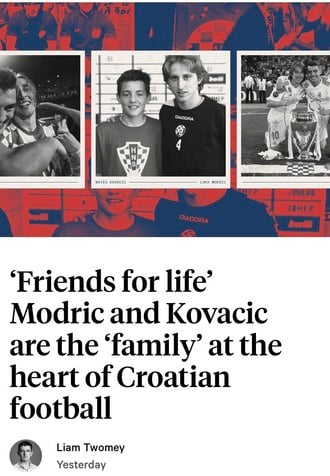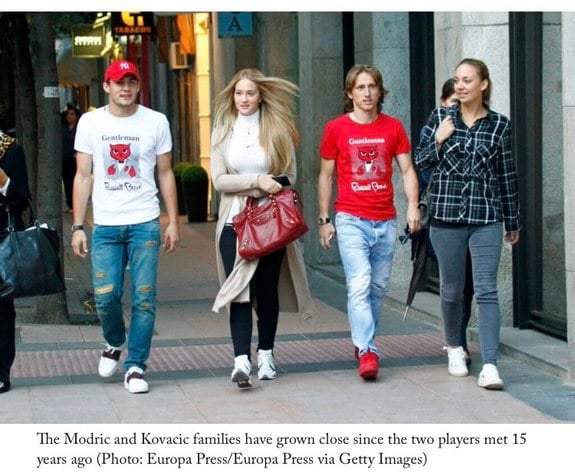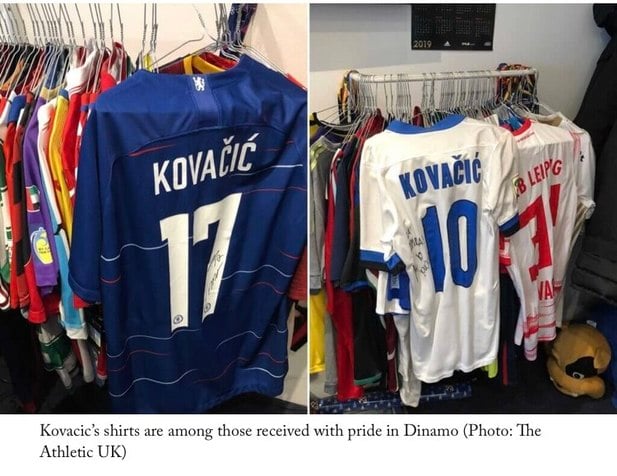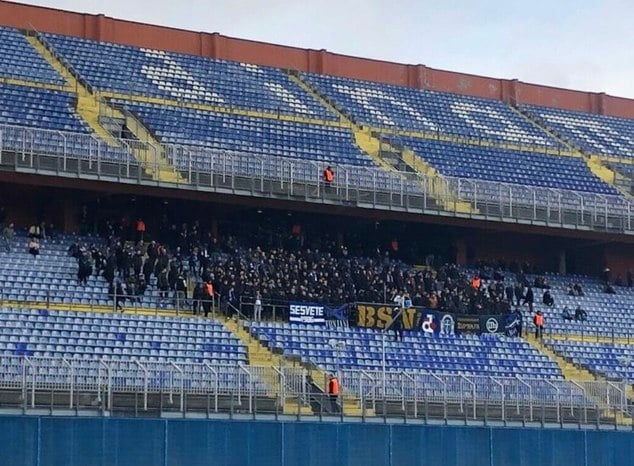
-
 Eduardo
27.8kVarane je igrao u jednoj od najboljih momčadi svih vremena i bio standardan. Osim toga je svjetski prvak i tu je također bio standardan. Sad igra u unitedu gdje je kaos i to mu malo kvari dojam, ali tamo ni van dijk ne bi izgledao dobro. — marcio amoroso
Eduardo
27.8kVarane je igrao u jednoj od najboljih momčadi svih vremena i bio standardan. Osim toga je svjetski prvak i tu je također bio standardan. Sad igra u unitedu gdje je kaos i to mu malo kvari dojam, ali tamo ni van dijk ne bi izgledao dobro. — marcio amoroso
Baš krenuo pisati nešto na tvom tragu. Čovjek ima 360 utakmica u Realu! Ono što nije olakotna okolnost je ta što je Varane igrački odrastao u tom klubu i to na poziciji stopera. Nije došao tamo kao gotov igrač. Sa 18 godina debitirati u takvom klubu, na takvoj poziciji, odigrati toliko tekmi i osvojiti sve što je osvojio... može ga se svrstati u red velikana i nitko ne bi mogao ništa prigovoriti na to. -
 Navijač Dinama
11.3ki još je izbacio standarndog Pepea sa mjesta startnog stopera i prvi izbor u prvoj reprezentaciji svijeta u kojem izbor stopera nije baš toliko lagan.
Navijač Dinama
11.3ki još je izbacio standarndog Pepea sa mjesta startnog stopera i prvi izbor u prvoj reprezentaciji svijeta u kojem izbor stopera nije baš toliko lagan. -

-

-
 Mali dioničar
19.1kAutor Liam Twomey, jučer izašlo na Athletic…
Mali dioničar
19.1kAutor Liam Twomey, jučer izašlo na Athletic…

In the offices behind the west tribune of the Maksimir Stadium there is a door bearing a black-and-white collage of iconic photographs from Dinamo Zagreb’s history. It is a collection that stretches all the way back to 1945, when the club once known as HSK Gradanski was re-formed as FD Dinamo in the shadow of the Second World War and entered into the Yugoslav First League. In the middle, just above the famous image of former Dinamo captain Zvonimir Boban kicking a police officer during the 1990 riot at the stadium against Crvena Zvezda, is a picture that stands out both in its style and relative modernity.
It was taken in 2007 at Dinamo’s training ground next to the Maksimir and shows a fresh-faced Luka Modric, then established as the star playmaker of the club’s first team, posing with his arm around a shy academy prospect by the name of Mateo Kovacic. At the time, neither the man nor the boy had any reason to suspect it would prove the precursor to a remarkable friendship that has come to define Croatian football, as well as providing an intriguing backdrop to a second Champions League knockout clash between Real Madrid and Chelsea in as many years.
“They didn’t have a big contact then,” says Dinamo Under-19 coach Jozo Bandic, who coached Kovacic at under-15 and under-17 level. “Mateo was just an admirer of Luka, like all the kids in the club. Luka was the No 10, the best player, their idol. Mateo wanted to be him.”
Now they are in the process of forging lifelong bonds; last summer Kovacic and his wife Izabel named Modric godfather to their son Ivan at a christening ceremony near Zadar, the coastal Dalmatian city where Modric grew up and close to where Kovacic’s parents have a holiday home.
The Modric and Kovacic families have grown close since the two players met 15 years ago (Photo: Europa Press/Europa Press via Getty Images)
The 15 intervening years are the story of two men moving beyond the mentor-protege dynamic established with that Dinamo photograph to become teammates for Real Madrid and the Croatia national team, and then — as Modric enjoys a glorious final act to a glittering career and Kovacic carves out space for himself on the elite stage at Chelsea — come to regard one another as family.
For Kovacic, it was awe. By the time he broke into Dinamo’s first team aged 16 years and 198 days in November 2010, Modric had put his early struggles at Tottenham Hotspur behind him and established himself as a genuine Premier League star. Shortly after Kovacic earned his first senior Croatia call-up in August 2012, Modric was cementing his status as one of the world’s most revered midfielders by completing a £30 million transfer to Real Madrid.
“I brought Mateo Luka’s shirt from Real Madrid,” says a smiling Marko Vukelic, Dinamo’s long-serving assistant sporting director. “He was so happy because Luka was his idol.”
Kovacic did not model his game on Modric; in some of his earliest interviews at Dinamo he instead cites Barcelona legend Andres Iniesta as his direct football influence. The attraction was more the promise held by Modric’s stratospheric journey from Dinamo to global renown — even if, on the surface, his own path through Croatia’s most prolific and celebrated academy was rather different from the man he aspired to follow.
Modric arrived at Dinamo from hometown club NK Zadar as a 16-year-old in 2001, and initially struggled to get into a very talented under-19 side. It was only after proving himself during excellent loan spells at Bosnian club Zrinjski Mostar and Inter Zapresic back in his homeland that his status as the bright young hope of Croatian football became unquestionable. “He has the quality, but in Luka’s whole story it’s his character that made the difference,” Vukelic adds.
In contrast, Kovacic was widely regarded as a prodigy when Dinamo acquired him from LASK Linz at the age of 13. The test that sharpened his desire to succeed was of a different type; at 14 he suffered a horrific broken leg in a tackle during a match against Osijek and was sidelined for nine months. “The doctor said if he broke it a couple of millimetres in the other direction it would have been much worse,” Bandic recalls.
It didn’t stop him for long. “Mateo played for Dinamo at 16 because he was amazing,” Vukelic says. “He took the ball and was too fast for everybody. It was too easy for him. With one movement he could put two or three players behind him. They couldn’t catch Mateo to kick him.”
Bandic also points to an event further in the past that marks the families of both men: the Croatian War of Independence, fought from 1991 to 1995, that forced Modric to flee from his home village of Zaton Obrovacki to Zadar as a boy, while the younger Kovacic was born in Linz because his parents had moved to Austria to escape the brutal violence of the conflict.
But ultimately, theirs is a connection of personalities. “It’s amazing that a player in today’s world, where you are so famous, can be as normal as Mateo is,” Bandic adds. “That’s also a similarity with Luka. They are polite, normal guys. They are both 100 per cent focused on the pitch. They are both also really smart players who understand how football needs to be played.”
For Modric, it was respect. He may not have given a second thought to the boy who asked for a picture with him in 2007, but on his regular visits to Zagreb while a Tottenham player — he and teammate Vedran Corluka would often say hello to old friends at Dinamo during the summer break — he quickly became aware of Kovacic’s lightning progress to the first team and rare talent on the ball.
Kovacic’s first senior appearance for Croatia came in a World Cup qualifier against Serbia in March 2013, partnering Modric in the heart of midfield. The pair struck up an easy chemistry on the pitch while off it Modric, by then 27 and growing in prominence at Real Madrid, quickly took his fellow Dinamo graduate under his wing at international camps and treated him like a younger brother.
Two months earlier, Kovacic had left Dinamo to join Inter, where the next stage in his technical development was underpinned by a physical transformation that turned him from a skinny boy into a muscular man. “Mateo came back here to visit after six months at Inter and he couldn’t fit through that door,” jokes Vukelic, pointing to the door of his office.
Modric continued to track his younger countryman’s progression in Italy with interest, and by the summer of 2015 decided to go one step further. In his autobiography, he details his proactive role in bringing Kovacic from Milan to Madrid after watching him sparkle during a pre-season friendly against Inter in Guangzhou.
“I watched the game from the bench, which allowed me to focus on Kovacic’s excellent performance,” Modric wrote. “Real won 3-0 but Mateo was the talk of the town. After the match, we were flying to Shanghai, where we would play against AC Milan. On the plane, I told President (Florentino) Perez, who was also impressed by Kovacic, ‘We should bring him to Real’.
“I saw the president was intrigued by Kovacic’s performance, but he replied, ‘Maybe next year’.
“‘Someone else will snatch him,’ I insisted. After dinner I passed by President Perez’s table. I mentioned Kovacic once again, and this time it was clear he was interested.
“A couple of days after we returned from the tour, Jose Angel Sanchez, the Real Madrid CEO, came to the club’s camp. He asked me what I thought of Mateo, not just as a player, but also as a person. I told him I thought the best of him on both counts, because he was an excellent young man and an exceptional talent. I also remarked that Real should sign him as soon as possible.”
Three weeks later, the deal — worth €29 million — was done. Kovacic was publicly earmarked as Modric’s heir for club and country, but privately their relationship grew closer and more equal; Modric drove the new signing to and from training at Valdebebas and they socialised regularly with their wives and Modric’s children.


Kovacic and Modric celebrate winning the Champions League in 2017 after the latter talked Real into signing him (Photo: JAVIER SORIANO/AFP via Getty Images)
“When I came to Madrid, our friendship became incredible,” Kovacic later said in an interview with Chelsea. “He gave me a lot of attention and we were together all the time.”
The only significant accommodation Modric failed to make for Kovacic in Madrid was to abide by the succession plan on the pitch. Rather than decline, his performances scaled new heights alongside Toni Kroos and Casemiro, and Kovacic grew frustrated with his persistently peripheral role in a new Champions League-winning dynasty.
It says a lot for the strength of their relationship that this professional tension never manifested personally, and when Kovacic finally ran out of patience and agreed to join Chelsea on loan in August 2018, he almost immediately revealed that Modric had recommended London as a city and given him advice on how to settle quickly.
For Dinamo, it is pride. Vukelic’s face lights up whenever he talks about the young Modric and Kovacic, and it is clear their achievements have been held up to the hundreds of academy prospects who have passed through Croatia’s premier football talent factory in the subsequent years. “Both of them are amazing characters, hard workers — like a lot of the kids in our academy, hungry for success,” he says.
In fact, Vukelic has even directly utilised Modric to motivate Dinamo youngsters. “When our under-19s played Liverpool in the UEFA Youth League (in 2019), I called Luka and asked him to send me a video of support to the kids. He said good luck, always they must give 120 per cent, Dinamo is the best in that way so go and win. I went into the dressing room before the game and showed them the video and they were crying — it was the best motivation for them.” Dinamo won 4-3 on penalties.
Last year, a study by CIES Football Observatory revealed that Dinamo had produced 70 players active in the 31 top divisions of UEFA member countries; only Ajax (81) and Shakhtar Donetsk (75) had more. It is an incredible development record, and one that prompted a 16-year-old Dani Olmo to leave Barcelona’s famed La Masia academy in 2014 and spend his formative footballing years in Zagreb. He broke into the senior Spain squad before joining RB Leipzig in January 2020.
“Every time Dani Olmo has a few days off, he comes to Zagreb,” says Ivan Svedi, Dinamo’s other assistant sporting director who shares Vukelic’s office to which former academy players send back the shirts of their new clubs. “He was only here for five years but it’s like home for him.”
Modric and Kovacic, however, clearly headline the elite group in the home-grown Dinamo academy pantheon. “We have had a lot of talents here as kids — but maybe only five or six of that level,” Vukelic says. “Modric, Kovacic, (Alen) Halilovic, (Josko) Gvardiol, (Josip) Brekalo, (Andrej) Kramaric.”

Kovacic’s shirts are among those received with pride in Dinamo (Photo: The Athletic UK)
It is matchday in Zagreb, but it feels far removed from the weekly excitement generated by Modric and Kovacic during their time at the club. Dinamo’s league opponents are the Prva HNL’s bottom club, Hrvatski Dragovoljac. They are all but relegated and are accompanied by precisely zero fans.
There are few fans of any allegiance at the Maksimir. The official attendance is recorded as 2,029, primarily consisting of a small but vocal core of Dinamo’s famous ultras, the Bad Blue Boys, and several large groups of schoolchildren who soundtrack every chance for the home team with high-pitched squeals.

The stadium itself is also looking worse for wear; the last meaningful renovations took place in 1998, and the entire east tribune has been closed since Zagreb was hit by a 6.4 magnitude earthquake in March 2020. The demolition of this stadium and construction of a brand new 30,000-seater arena on the site were initially slated to begin in 2022, but Dinamo and the city council have so far been unable to agree on how it will be financed.
Dinamo kick off knowing they are nine matches away from securing a 23rd league title and the club’s fifth in a row, but this is one of their less inspiring performances. The home side’s midfield is sorely lacking the guile and precision that distinguished Modric and Kovacic during their time here.
That is until the 78th minute, when 19-year-old Martin Baturina is introduced. The son of Croatian attacking midfielder and one-cap international Mate Baturina, he immediately looks technically superior to every other player on the pitch, receiving and offloading the ball in tight spaces with smooth, sharp touches.
Three minutes after coming on he brings the ball down on his right thigh a little way into the Hrvatski half, freezes two opponents with two small touches before bursting into the gap between them, then touches the ball past another defender as he races into the penalty area.
The thrilling sequence ends with him flashing a low ball across the six-yard box that Ivan Smolcic can only divert into his own net, giving Baturina his fourth league assist of the season in nine appearances. Dinamo’s victory is assured by a timely reminder that, whatever the club’s challenges, the academy conveyer belt that produced Modric and Kovacic is still running.
“My successor in Croatia and the most talented player, I think, is Mateo Kovacic,” Modric said in an interview with Marca in February. “Although he is not a youngster, he is already a grown player. He has played for important clubs like Inter Milan, Real Madrid, now he is at Chelsea doing things very well and that’s why I say that he is one of the successors, he can be the leader of the next Croatia.”
The question of when the succession will take place remains an open one. Modric has suggested he could play until he is 40 and while the consensus in Croatia is that the coming World Cup in Qatar will be his last, that was also a popular assumption at Russia in 2018. Instead, he won the Golden Ball after leading his country to the final, and capped that success by breaking the dual hold of Lionel Messi and Cristiano Ronaldo on the Ballon d’Or.
Modric and his wife Vanja were visiting Kovacic and his wife Izabel in London when he was told the news — and immediately sworn to secrecy. “I love Mateo like my kid brother,” he recalls in his autobiography. “He’s a great guy and a fantastic player. Despite our close friendship, I succeeded in the toughest mission of the day: hiding my euphoria. Not being allowed to reveal the fantastic news of winning the Ballon d’Or to anyone was tough. I didn’t know where I was from all the excitement.”
Leaving the shadow of Modric in Madrid has enabled Kovacic to establish his own world-class midfield credentials at Chelsea, though an unfortunately-timed hamstring injury prevented him from showcasing them when the two clubs met in last season’s Champions League semi-finals. He still managed to help out teammate Mason Mount, another admirer of his friend.
“I spoke to Kovacic before the first game and asked if I could get (Modric’s) shirt at a later date,” Mount said later. “I managed to do that and he asked for mine in the second game because I didn’t actually give him mine in the first. Kova said he likes to swap with players so he came up and said he wanted mine, and just said good luck in the upcoming games.
“It was brilliant for me to speak to him and that he wanted my shirt, so I was quite overwhelmed.”
The friendship between Modric and Kovacic is becoming increasingly public outside the realm of football in Croatia; earlier this year they appeared together in an advert for a new clothing range by eco-fashion brand Lunilou, run by Kovacic’s wife Izabel and her sister Ivana. That trend is likely to continue whenever Modric finally decides to hang up his boots.
“Football connected us, but outside the pitch is the most important thing,” Kovacic said of their friendship. “It’s great to have friends like him, and it’s for a lifetime.” -

-

-
 og1986
2.9kCIES je objavio da je gvardiol najvrjedniji mladi igrač (under 23).
og1986
2.9kCIES je objavio da je gvardiol najvrjedniji mladi igrač (under 23).
Gotovo sigurno će skinuti novi rekord transfera za braniča jer ga procjenjuju na vrijednost od 96.2 milijuna eura.
Drugi u poretku je isto igrač leipziga szoboslai (60mil), a treći barcin gavi (58mil).
Nek Joško pametno odabere. :smile: -


Dobrodošli na Forum Zona Dinamo!
Zona Dinamo je Forum na kojem se okupljaju navijači i simpatizeri Dinama, te na jednom mjestu raspravljaju i informiraju se o klubu i svim ostalim stvarima koje imaju poveznicu s našim klubom. Ostali su dobrodošli kao gosti i u skladu s tim trebaju se i ponašati.
















